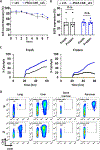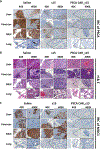Off-the-Shelf Prostate Stem Cell Antigen-Directed Chimeric Antigen Receptor Natural Killer Cell Therapy to Treat Pancreatic Cancer
- PMID: 34999097
- PMCID: PMC8963130
- DOI: 10.1053/j.gastro.2021.12.281
Off-the-Shelf Prostate Stem Cell Antigen-Directed Chimeric Antigen Receptor Natural Killer Cell Therapy to Treat Pancreatic Cancer
Abstract
Background & aims: Pancreatic cancer (PC) is the third leading cause of cancer-related death with a 5-year survival rate of approximately 10%. It typically presents as a late-stage incurable cancer and chemotherapy provides modest benefit. Here, we demonstrate the feasibility, safety, and potency of a novel human natural killer (NK) cell-based immunotherapy to treat PC.
Methods: The expression of prostate stem cell antigen (PSCA) was evaluated in primary PC at messenger RNA and protein levels. The processes of retroviral transduction, expansion, activation, and cryopreservation of primary human NK cells obtained from umbilical cord blood were optimized, allowing us to develop frozen, off-the-shelf, allogeneic PSCA chimeric antigen receptor (CAR) NK cells. The safety and efficacy of PSCA CAR NK cells also expressing soluble (s) interleukin 15 (PSCA CAR_s15 NK cells) were evaluated in vitro and in vivo.
Results: PSCA was elevated in primary human PC compared with the adjacent or other normal tissues. PSCA CAR_s15 NK cells displayed significant tumor-suppressive effects against PSCA(+) PC in vitro before and after 1 cycle of freeze-thaw. The viability of frozen PSCA CAR_s15 NK cells persisted more than 90 days in vivo after their last infusion and significantly prolonged the survival of mice engrafted with human PC.
Conclusions: PSCA CAR_s15 NK cells showed therapeutic efficacy in human metastatic PC models without signs of systematic toxicity, providing a strong rationale to support clinical development.
Keywords: Immunotherapy; Innate Immunity; NK Cell; Pancreatic Cancer; Pancreatic Ductal Adenocarcinoma.
Copyright © 2022. Published by Elsevier Inc.
Conflict of interest statement
Figures







References
-
- Society AC. Cancer Facts & Figures 2021. Cancer Statistics Center 2021.
-
- Mota Reyes C, Teller S, Muckenhuber A, et al. Neoadjuvant Therapy Remodels the Pancreatic Cancer Microenvironment via Depletion of Protumorigenic Immune Cells. 2020;26:220–231. - PubMed
Publication types
MeSH terms
Substances
Grants and funding
LinkOut - more resources
Full Text Sources
Other Literature Sources
Medical

